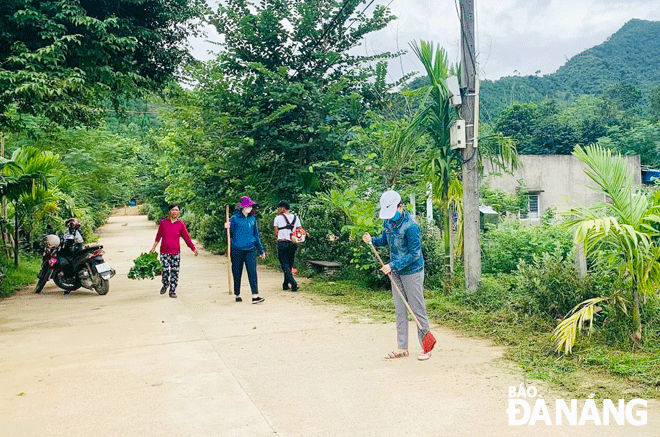Co Tu people actively get involved in environmental protection
Ta Lang and Gian Bi villages in Hoa Bac Commune, Hoa Vang Suburban District, Da Nang, amaze visitors with long stretches of roads, clean and airy roads which are covered with a canopy of trees. The positive results are mainly attributed to great efforts the Co Tu ethnic minority people have made to protect the environment in recent years, thereby bringing a new face to the city’s rural areas, and making the landscape of the city’s mountainous areas beautiful.
 |
| Villagers of the Ta Lang village participating in environmental cleanups to keep their local areas litter free. Photo: H.V |
Ta Lang and Gian Bi villages are located about 30km from Da Nang’s center, in the upstream part of the Cu De River in which there are many primeval forests with rich in natural resources, and diversity of plant and animal communities. These two villages are quite close to each other, and the majority of their villagers are the Co Tu people. In recent years, the Co Tu people have gradually increased their awareness about environmental issues, and they, therefore, have a responsibility to protect their long-term living conditions.
Ms. Nguyen Thi Lan, the Chairwoman of the Ta Lang Village Chapter of the Da Nang Women's Union, remarked that the village’s environmental movement has produced positive results in recent years. The villagers have been active in planting trees and protecting their trees, using energy and water economically and efficiently, taking action to reduce plastic waste, stopping to use or burn single-use plastic bags, and using eco-friendly products with the aim of not harming the environment or the ecology during their production, use, or disposal, as well as getting involved in solid waste classification at source, and utilizing food waste such as fruit peels and vegetable scraps for production of dish-washing and floor cleaning liquid in an effort to develop the ‘Environmentally Friendly Residential Area’ model. Many women in the village have actively got involved in collecting food waste from their kitchen such as peels of grapefruit, orange, and lemon to create dish-washing and floor cleaning liquid in an attempt to make their small contribution to environmental protection.
Mr. Dinh Van Hin, the Head of the Ta Lang village, said that the village has 123 households with 379 people in total. All villagers have played their part in protecting the environment by doing their smallest things such as stopping to throw their rubbish indiscriminately, cleaning roads and alleys on Sundays in order to keep their residential areas green, clean and beautiful.
In a similar move, Gian Bi Village has developed diverse ways to protect the environment. Focus has been on encouraging active involvement of the villagers in classification of domestic solid waste at source, planting trees along concrete roads, and recycling waste materials from their yard, kitchen, and garden into a fertilizer.
“We regularly focus on increasing environmental awareness among our residents. As a result, all of the villagers have stopped the burning and indiscriminate dumping of rubbish, as well as actively got involving in recycling domestic waste. In the future, we will actively get involved in recycling as a method to raise funds for charitable and social activities. The money raised from the sale of recyclables will be used to visit sick persons or give gifts to poor women, and give candy to children on public holidays and Lunar New Year . Environmental protection models not only help improve the quality of villagers’ life but also spread the spirit of solidarity and good neighborliness in local communities," Ms. Hanh, the Vice Chairwoman of Gian Bi Village Chapter of the Da Nang Women’s Union.
Awareness raising campaigns have promoted behaviour change for strengthening waste segregation at source among residents in Ta Lang and Gian Bi villages by encouraging their active involvement in recycling activities, and turning their food waste into dish-washing and floor cleaning liquid, as well as increasing the use of environmentally friendly products. Benefits of environmental protection models developed by residents of Ta Lang and Gian Bi villages, and Hoa Bac Commune as a whole, will surprise anyone who visits these villages.
Reporting by H.V – Translating by H.L







